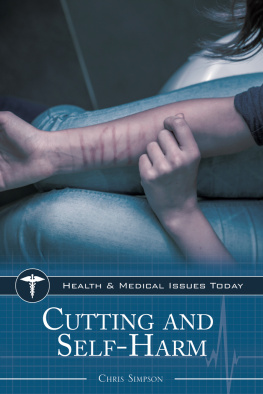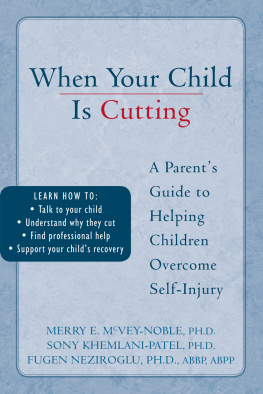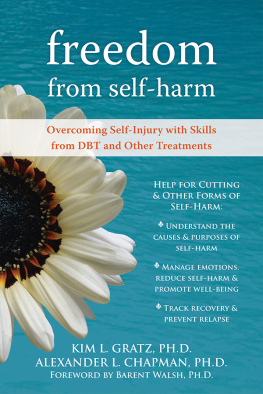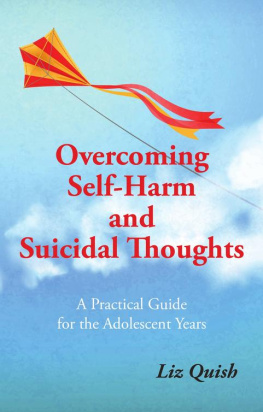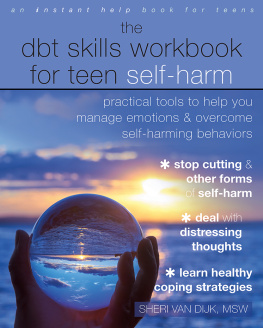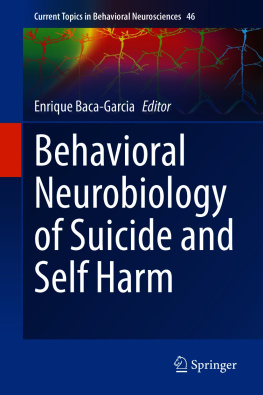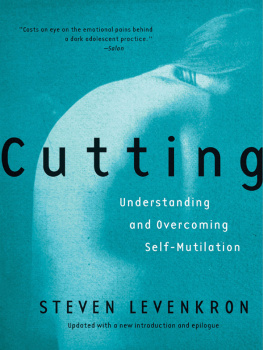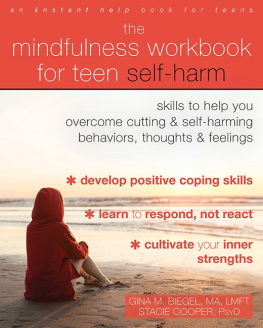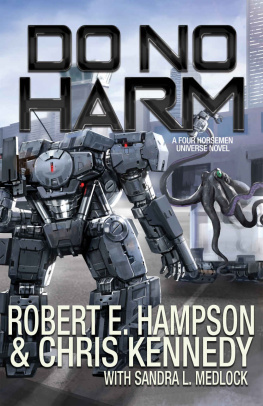CUTTING AND SELF-HARM
Chris Simpson
Health and Medical Issues Today

Copyright 2015 by ABC-CLIO, LLC
All rights reserved. No part of this publication may be reproduced, stored in a retrieval system, or transmitted, in any form or by any means, electronic, mechanical, photocopying, recording, or otherwise, except for the inclusion of brief quotations in a review, without prior permission in writing from the publisher.
Library of Congress Cataloging-in-Publication Data
Simpson, Chris, 1969
Cutting and self-harm / Chris Simpson.
pages cm. (Health and medical issues today)
Includes bibliographical references and index.
ISBN 9781610698726 (hardback : acid-free paper) ISBN 9781610698733 (ebook) 1. Cutting (Self-mutilation) 2. Self-injurious behavior. I. Title.
RC569.5.S48S562015
616.8582dc232015012173
ISBN: 9781610698726
EISBN: 9781610698733
19 18 17 16 15 1 2 3 4 5
This book is also available on the World Wide Web as an eBook.
Visit www.abc-clio.com for details.
Greenwood
An Imprint of ABC-CLIO, LLC
ABC-CLIO, LLC
130 Cremona Drive, P.O. Box 1911
Santa Barbara, California 93116-1911
This book is printed on acid-free paper 
Manufactured in the United States of America
This book discusses treatments (including types of medication and mental health therapies), diagnostic tests for various symptoms and mental health disorders, and organizations. The authors have made every effort to present accurate and up-to-date information. However, the information in this book is not intended to recommend or endorse particular treatments or organizations, or substitute for the care or medical advice of a qualified health professional, or used to alter any medical therapy without a medical doctor's advice. Specific situations may require specific therapeutic approaches not included in this book. For those reasons, we recommend that readers follow the advice of qualified health care professionals directly involved in their care. Readers who suspect they may have specific medical problems should consult a physician about any suggestions made in this book.
CONTENTS
SERIES FOREWORD
Every day, the public is bombarded with information on developments in medicine and health care. Whether it is on the latest techniques in treatment or research, or on concerns over public health threats, this information directly affects the lives of people more than almost any other issue. Although there are many sources for understanding these topicsfrom Web sites and blogs to newspapers and magazinesstudents and ordinary citizens often need one resource that makes sense of the complex health and medical issues affecting their daily lives.
The Health and Medical Issues Today series provides just such a one-stop resource for obtaining a solid overview of the most controversial areas of health care in the 21st century. Each volume addresses one topic and provides a balanced summary of what is known. These volumes provide an excellent first step for students and lay people interested in understanding how health care works in our society today.
Each volume is broken into several sections to provide readers and researchers with easy access to the information they need:
Part I provides overview chapters on background informationincluding chapters on such areas as the historical, scientific, medical, social, and legal issues involvedthat an individual needs to intelligently understand the topic.
Part II provides capsule examinations of the most heated contemporary issues and debates, and analyzes in a balanced manner the viewpoints held by various advocates in the debates.
Part III provides a selection of reference material, such as annotated primary source documents, a timeline of important events, and a directory of organizations that serve as the best next step in learning about the topic at hand.
The Health and Medical Issues Today series strives to provide readers with all the information needed to begin making sense of some of the most important debates going on in the world today. The series includes volumes on such topics as stem-cell research, obesity, gene therapy, alternative medicine, organ transplantation, mental health, and more.
PREFACE
I remember the first time I encountered a self-injuring client. I was a newly minted, licensed professional counselor intern working in an intensive outpatient chemical dependency program. I noticed the forearm of a client one day. He had what appeared to be small, round holes in his right forearm. I asked, What happened to your arm? His response was, Sometimes I put a cigarette out in my arm. It sort of snaps me out of it. At the time, I was not sure what it would have been. In fact, I genuinely did not conceive self-injurious behavior. From that point, I began to notice the behavior in other clients, and my quest for understanding began.
I realized that, while confusing to most of us, self-injury actually serves a very real purpose for the individual employing the behavior. The purpose of this book is to clarify the motivations for the behavior and highlight the components that surround self-injury. describes the process of treatment of self-injury.
of the book provides a variety of resources including related books, websites, and articles. Some important documents are included, as well as a glossary, timeline, and bibliography.
This book was designed to address the most topical and relevant issues surrounding the behavior of self-injury. Hopefully, parents, friends, mental health professionals, and those who practice self-injury can find this book useful.
ACKNOWLEDGMENTS
To begin, I would like to thank my friends at ABC-CLIO. Your faith in my ability to write this manuscript is greatly appreciated.
To my colleagues who granted interviews, support, and endless phone calls, I thank you for your patience and willingness.
To my mother, Delpha, thanks for being my encouraging voice. Just like a mom, you were always willing to offer words of encouragement.
To my dad, Jeff, thanks for sharing in the pride and joy of completing this manuscript. It means more than you know.
And, finally, to my wife, Kristin, thank you for your endless encouragement and understanding through this process and so many others. Your love and grace mean so much. You are the greatest partner I could ever hope for. I love you very much.
PART I
Cutting and Self-Harm: What Are They and How Do They Occur?
CHAPTER 1
Cutting and Self-Harm: Definitions, History, and Basic Characteristics
Cutting and self-harm have served as confusing and troubling behaviors in North American and European cultures especially since the late twentieth century. The amount of literature, nonfiction and fiction alike, on the subject has increased substantially since the early 1980s. Self-harm has worked its way into popular culture through movies, books, and electronic media. More reports of self-harming behaviors have emerged in schools and clinical settings like treatment facilities and hospitals. Self-harm has developed into a very tangible and, for many, terrifying behavior that demands the attention of communities and helping professionals alike. As the world has become more informed of the potential dangers of this behavior, self-harm has become more globally recognized as a health threat to those who commit such acts.
While there is a great deal of evidence that would suggest cutting and self-harm have existed for hundreds or even thousands of years, modern society has difficulty tolerating the existence of this phenomenon. Mental health professionals, parents, teachers, friends, and caregivers often find themselves in distress when faced with the prospect of managing or even confronting a loved one who commits self-harm. This distress has manifested itself honestly as stopping self-injurious behavior can be both difficult and painful for all involved.
Next page
